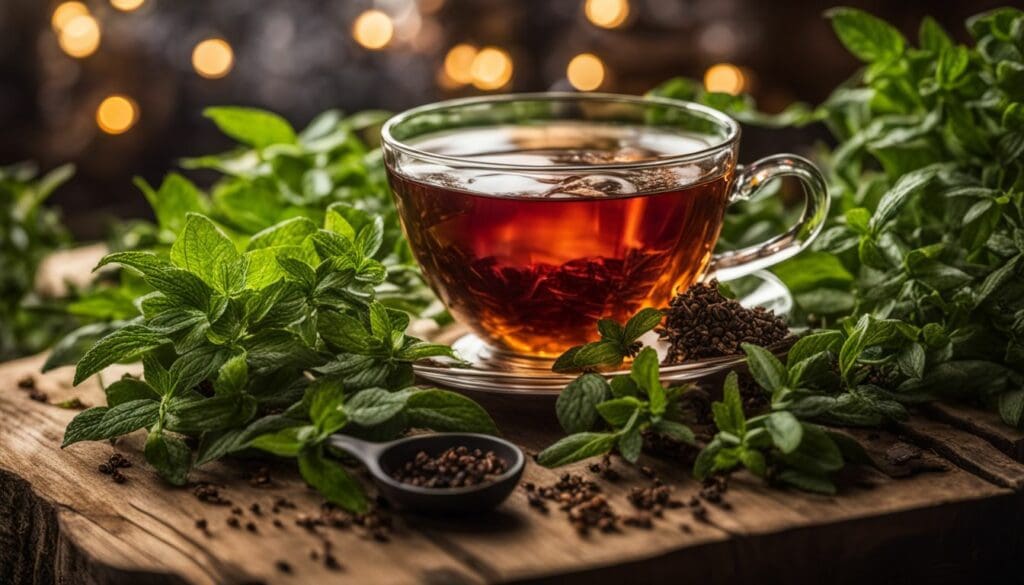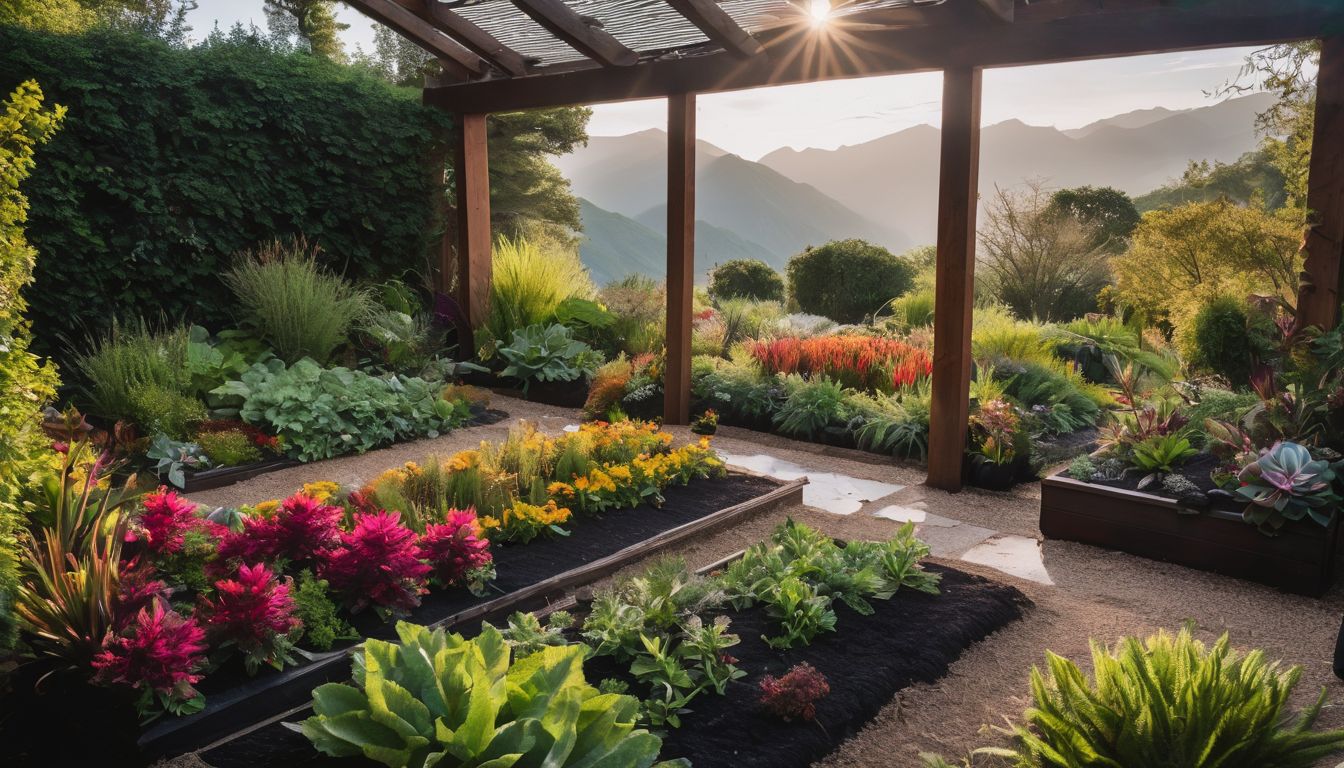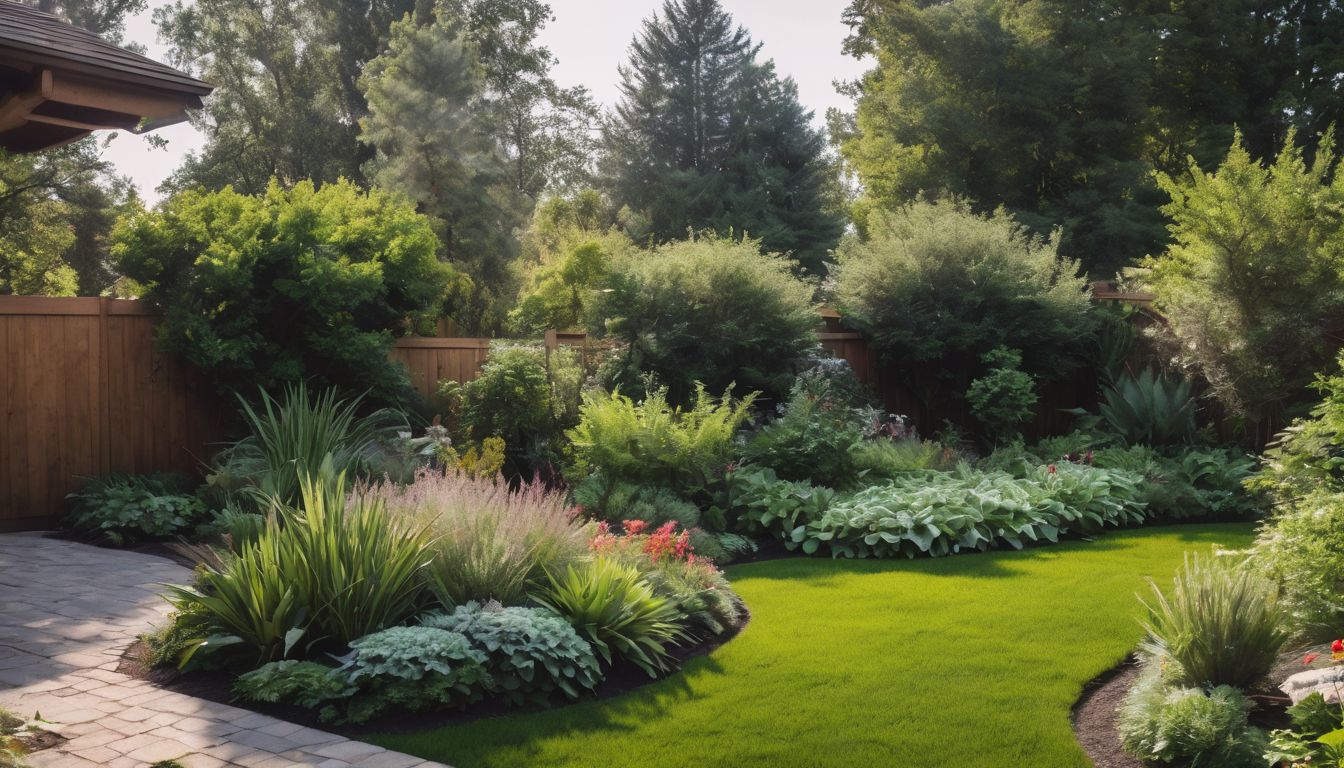Tired of dull store-bought tea? An estimated 84% of the population drink tea, and a growing number are turning towards natural, homegrown options. This blog will guide you through creating a lush herbal tea garden right in your backyard so you can sip on healthful and flavourful teas tailored just for you.
Let’s dig in!
Key Takeaways
- Starting your own herbal tea garden is an eco-friendly and cost-saving way to enjoy fresh, personalised blends.
- Essential herbs like chamomile, rosemary, elderberry, lemon balm and peppermint provide a range of flavours and health benefits for your homemade teas.
- To successfully grow these herbs, choose a sunny spot with well – drained soil and protect plants from strong winds. Regular watering and occasional fertilisation will help them thrive.
- Harvest herbs in the morning when their oils are most potent; dry them properly to maintain flavour before storing in air-tight containers away from light and heat.
- Companion planting can enhance herb growth by attracting beneficial pollinators such as bees and butterflies while deterring pests.
Why Grow a Tea Garden?
Growing a tea garden is not only beneficial for your health but also cost-effective and allows you to personalize your own blends of herbal teas.
Cost-effective
To grow your own herbal tea garden is not only beneficial for health but also cost-effective. By cultivating your own herbs, one can save money on store-bought tea blends and enjoy a constant supply of fresh, high-quality ingredients without breaking the bank.
This sustainable approach to tea cultivation aligns with environmentally conscious values while providing an affordable and accessible way to indulge in personalized herbal remedies.
By growing your own herbs, you can support conservation efforts and reduce the environmental impact associated with commercial tea production. The cost-effectiveness of cultivating a homegrown tea garden allows individuals to embrace self-sufficiency while contributing positively to the preservation of natural resources.
Personalized blends
To create personalized blends, experiment with different combinations of herbs from your garden to develop unique tea flavors. Consider mixing chamomile and lemon balm for a soothing and refreshing blend, or try blending peppermint and rosemary for a zesty and invigorating taste.
Get creative with your herb combinations to tailor the flavor profile to suit your personal preferences. By growing your own herbs, you have the flexibility to customize blends that are not available in stores, allowing you to enjoy truly bespoke herbal teas.
As part of an environmentally conscious lifestyle, homegrown personalized blends provide a sustainable alternative to commercial teas by reducing packaging waste and transportation emissions associated with store-bought products.
Essential Herbs for a Tea Garden
When it comes to growing your own herbal tea garden, there are a few essential herbs that you’ll want to include. Bee balm, chamomile, rosemary, elderberry, lemon balm and peppermint are all great options for creating delicious homemade teas.
Chamomile
Chamomile, with its delicate daisy-like flowers and calming fragrance, is a must-have for any herbal tea garden. This herb, known for its soothing properties, can help to reduce stress and promote relaxation when brewed into a warm cup of tea.
Chamomile is also rich in antioxidants and has been used for centuries to aid digestion and alleviate symptoms of colds or flu. Additionally, chamomile can be harvested and dried easily for long-term storage, making it convenient to have on hand whenever you need a comforting brew.
Furthermore, cultivating chamomile in your tea garden not only benefits your wellbeing but also supports the environment by providing food for pollinators such as bees and butterflies.
Rosemary
Rosemary, a fragrant and versatile herb, is a must-have for any herbal tea garden. It adds an aromatic, earthy flavor to teas and is known for its medicinal properties. Rosemary has been used for centuries to improve digestion, boost memory, and reduce inflammation.
In addition to its health benefits, rosemary also attracts pollinators like bees and butterflies with its beautiful blue flowers, supporting biodiversity in your garden. As an environmentally conscious individual who values conservation and sustainability, cultivating rosemary in your tea garden not only enhances the flavors of your homemade blends but also contributes to the preservation of local ecosystems.
Elderberry
Elderberry is a versatile and beneficial herb to include in your tea garden due to its immune-boosting properties. It is rich in antioxidants and vitamin C, making it an excellent addition for homemade herbal teas.
The dark purple berries have a sweet-tart flavor that adds depth to tea blends, providing both taste and health benefits.
When cultivating elderberry in your garden, ensure it has well-draining soil and receives ample sunlight. Proper care will result in plentiful harvests, allowing you to enjoy the fruits of your labor through delicious homemade teas.
Lemon Balm
Lemon balm is a fragrant herb that adds a refreshing citrusy twist to herbal teas. It is also known for its calming properties, making it an excellent choice for those seeking relaxation in their tea blends.
This hardy perennial plant thrives in sun or partial shade and can be easily grown from seeds or transplants, making it a great addition to your homegrown tea garden. With its antiviral and antioxidant properties, lemon balm not only enhances the flavor of your teas but also provides potential health benefits, adding value to your homemade brews.
In addition to its use in teas, lemon balm can also be used in culinary dishes and even homemade skincare products due to its delightful aroma and soothing qualities. Its versatility makes it a valuable asset in any herb garden, offering both sensory pleasures and practical uses.
Peppermint
Peppermint is a versatile herb that is a must-have in any herbal tea garden. It’s known for its refreshing and cooling properties, making it an excellent addition to homemade teas.
The leaves can be used fresh or dried, offering a delightful minty flavor to your blends. Peppermint also has various health benefits, aiding digestion and providing relief from headaches and cold symptoms.
This low-maintenance herb thrives in well-drained soil and enjoys partial shade, making it suitable for both beginners and experienced gardeners alike.
How to Plant and Care for Your Tea Garden
Choose a sunny location with well-drained soil, plant your herbs, water them regularly and watch them thrive in your very own herbal tea garden. Interested in learning more about creating your own personalised blend of herbal teas? Keep reading to find out how!
Choosing the right location
When selecting a location for your herbal tea garden, consider a spot that receives at least six hours of sunlight per day. Partial shade is suitable for some herbs, but most thrive in full sun.
Additionally, ensure the area has well-draining soil to prevent waterlogging and root rot.
Planting your herbs in an area protected from strong winds will help prevent damage to delicate leaves and stems. Consider creating microclimates within your garden by utilising nearby structures or additional planting beds to shield more sensitive plants from harsh weather conditions.
Preparing the soil
After choosing the right location for your tea garden, it’s crucial to properly prepare the soil. Begin by clearing the area of any debris and weeds, then loosen the soil using a garden fork or tiller.
Adding organic matter such as compost or well-rotted manure will improve soil structure and provide essential nutrients for your herbs. Aim for a pH level of 6.0 to 7.5, which is ideal for most herbal plants.
Testing kits are available at garden centers to help you achieve the right balance.
Planting the herbs
Planting the herbs begins with selecting a sunny location for them to thrive. Ensure that the soil is well-drained and loamy. Dig individual holes for each herb, allowing enough space between them for growth.
Gently remove the plants from their containers or packaging and carefully place them in the prepared holes, covering with soil. Water the newly planted herbs thoroughly to help settle the soil around their roots.
After planting, remember to water your herbs regularly – typically once a week when rain is inadequate; however, be careful not to overwater as this can lead to root rot. Apply a layer of organic mulch around each plant to retain moisture and suppress weed growth.
Watering and fertilizing
To maintain a thriving herbal tea garden, ensure you water the plants regularly, particularly during dry spells. Herbs like bee balm and rosemary prefer well-drained soil, so be mindful not to overwater them.
When watering, aim for the base of the plants to avoid wetting the foliage excessively, which can lead to diseases. Fertilise your herbs sparingly with an organic fertiliser suitable for edible plants; too much nitrogen can compromise their flavour and medicinal properties.
When it comes to fertilising your herbal tea garden, opt for natural options such as compost or organic liquid fertilisers. Apply these in moderation during the growing season to avoid overwhelming the herbs with nutrients.
Harvesting tips
To maintain the flavor and potency of your herbal tea garden, harvest the leaves in the morning when their natural oils are at their peak. Use sharp scissors to clip the stems just above a leaf node, as this encourages new growth.
Gently wash the leaves with cool water and pat them dry before use.
When it comes to harvesting flowers for your tea blends, pick them just as they begin to open before any dew has evaporated. This ensures you capture all their aromatic qualities at their freshest.
Ensure that you store harvested herbs in a cool, dark place to preserve their flavor and medicinal properties effectively.
Brewing Your Homemade Herbal Tea
Dry and store herbs, blend them for flavour, and explore different brewing methods to create your personalised herbal tea. Whether it’s hot or iced, there are endless possibilities to enjoy your homegrown brews.
Read on to discover more about the art of brewing homemade herbal tea.
Drying and storing herbs
After harvesting your herbs, the next step is crucial – drying and storing them properly to retain their flavour and health benefits. To dry your herbs, tie small bunches together with string and hang them in a warm, well-ventilated area out of direct sunlight.
Once dried, store the herbs in airtight containers away from heat and light to preserve their potency. Be mindful of moisture buildup in storage as it can lead to mould growth. Label each container with the herb name and date of harvest for easy identification.
To keep your homemade herbal tea fresh for longer periods, consider investing in glass jars or tin containers with tight lids for optimal preservation. This method not only maintains the aroma but also ensures that you always have high-quality ingredients on hand when brewing your personalised blends.
Blending herbs for flavor
Blending herbs for flavor adds depth and complexity to your homemade herbal tea. Experiment with different combinations of bee balm, chamomile, rosemary, elderberry, lemon balm, and peppermint to create unique and personalised blends.
Adjust the ratios to find the perfect balance of floral, minty, citrusy or earthy notes that suit your taste preferences. Consider adding dried fruit peels or spices like cinnamon or ginger for an extra kick of flavour in your tea concoctions.
Once you’ve harvested and dried your herbs, get creative with blending! Mix small batches by hand or use a mortar and pestle for a more consistent texture. Store your custom blends in airtight containers away from light and heat to preserve their freshness.
Different brewing methods
Explore various brewing methods to extract the full flavor and health benefits from your homegrown herbal tea garden. Use traditional steeping for dried herbs, or try cold brewing for a refreshing, light flavor.
Experiment with hot infusion by pouring boiling water over fresh herbs or opt for a longer, slower process like sun tea to gently infuse the flavors. Harness the power of your own blend of medicinal herbs and create a truly unique tea experience that aligns with your sustainable lifestyle.
Employ innovative techniques such as using an electric kettle with variable temperature settings to achieve optimal brewing temperatures for each type of herb. For instance, use lower temperatures for delicate flowers and leaves like chamomile and higher temperatures for robust woody herbs such as rosemary and elderberry.
Additional Tips and Ideas
Aside from brewing tea, herbs can also be used for medicinal purposes and as natural remedies. Companion planting with other plants can help your tea garden thrive, while inviting beneficial pollinators like bees and butterflies.
Consider creative ways to display your herbs, such as in hanging baskets or decorative planters.
Using herbs for medicinal purposes
Using herbs for medicinal purposes offers a natural alternative to traditional medicine. Herbs like chamomile, peppermint, and elderberry have been used for centuries to alleviate ailments such as digestive issues, headaches, and insomnia.
Harness the healing power of these herbs by steeping them in hot water to create soothing teas or infusions. Additionally, herbs like rosemary and lemon balm possess antibacterial properties that can aid in supporting overall health and boosting the immune system.
These herbal remedies not only promote wellness but also reduce reliance on synthetic pharmaceuticals.
Aside from their health benefits, growing medicinal herbs in your tea garden supports environmental sustainability by reducing the use of chemical-laden medications while promoting conservation through organic gardening practices.
Companion planting for a thriving tea garden
To promote a thriving tea garden, consider companion planting to maximise the health and growth of your herbal plants. Planting herbs such as chamomile alongside your tea plants can attract beneficial insects like bees and ladybirds, which contribute to pollination and pest control.
Pairing peppermint with your rosemary can deter pests that may harm the growth of other herbs in the garden. Additionally, interplanting different types of herbs together can help improve soil quality and root structure by reducing competition for nutrients.
This holistic approach not only promotes a healthy garden but also supports environmental conservation by minimising the use of chemical pesticides.
By strategically positioning complementary herbs together in your garden, you create symbiotic relationships that benefit each plant’s overall well-being. For example, growing elderberry near bee balm can enhance both plants’ natural defences against diseases due to their synergistic properties.
And when lemon balm is planted near other herbs like chamomile or rosemary, it helps repel unwanted pests while promoting the growth of neighbouring plants through its aromatic qualities.
Inviting beneficial pollinators
To promote a thriving tea garden, attract beneficial pollinators like bees, butterflies, and hummingbirds. These creatures aid in pollination, leading to healthier plants and higher yields of herbs for brewing delicious teas.
Planting nectar-rich flowers such as lavender, sunflowers, and coneflowers alongside your herbal tea garden will help create an inviting environment for these important pollinators.
Integrating native plants into your garden is essential. They are adapted to the local climate and provide food and habitat for indigenous pollinators. By nurturing a diverse ecosystem in your tea garden, you contribute to biodiversity conservation while reaping the benefits of increased herb production for your homemade brews.
Creative ways to display your herbs
Once your herbs have been harvested, consider hanging them to dry. This not only preserves the herbs but also adds a rustic and aromatic touch to your living space. Another creative way to display your herbs is by using them as ornamental plants in your garden or on your windowsill, adding both beauty and functionality to your space.
Additionally, you can use glass jars and vases to showcase the vibrant colours and textures of your dried herbs while keeping them easily accessible for brewing.
To further maximise the visual impact of your herbal display, consider creating herb-themed DIY crafts such as wreaths or sachets that can be used as decoration or given as thoughtful gifts.
Conclusion
In conclusion, growing your own herbal tea garden offers an array of benefits for both your health and your wallet. Not only can you enjoy the pleasure of creating personalised blends tailored to your taste, but you also have the satisfaction of knowing that you are using natural, homegrown ingredients.
By carefully selecting and nurturing essential herbs like chamomile and peppermint, you can soon be savouring delicious homemade teas that are good for both you and the environment.
FAQs
1. Why should I grow my own herbal tea garden?
Growing your own herbal tea garden allows you to harvest fresh herbs, ensuring a supply of flavorful and aromatic leaves for your tea.
2. What do I need to start my own herbal tea garden?
To start your herbal tea garden, you’ll need some space in your yard or containers for planting, quality soil, and a selection of herb seeds or plants that are suitable for teas.
3. How do I care for the herbs in my tea garden?
Caring for the herbs involves regular watering, ensuring they get enough sunlight, trimming them as needed to encourage growth, and protecting them from pests.
4. Can all types of herbs be used for making tea?
Many herbs can be used to make delicious teas; however it’s important to choose the right ones such as mint, chamomile or lavender which are popular options known for their taste and health benefits when brewed.





